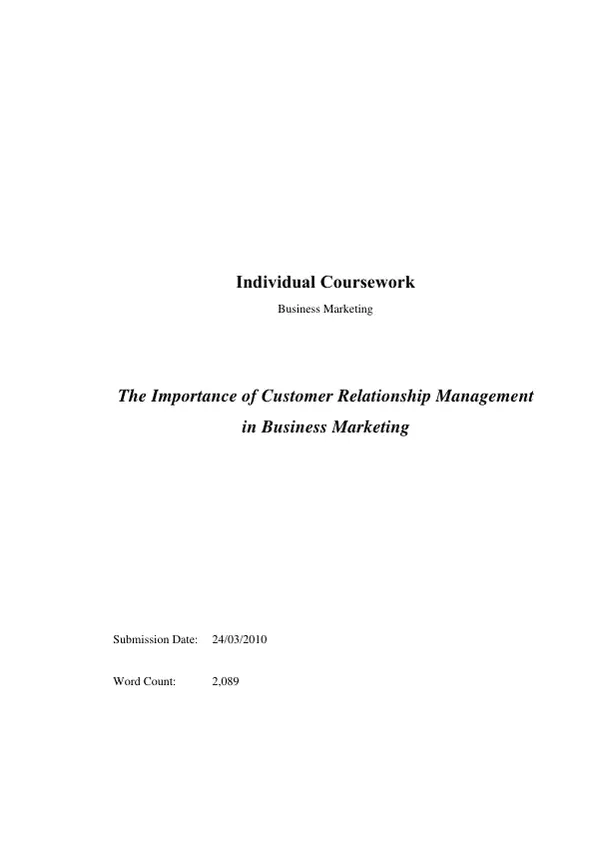An increased competitive situation on the basis of similar products, scarce resources, advancements in technology and changes in customer behaviour are forcing companies to consider a sustained and efficient structure of the provision of their services over and above a strong customer orientation. Customer relationship management (CRM), as a part of strategic marketing, can be seen as the emerging management paradigm, with which companies seek to respond to these changing market conditions.
Through the adoption of a CRM system, companies are able to collect and evaluate specific knowledge about their customers in a systematic way, hence primarily improving customer service and customer loyalty. Until recently, companies ignored the importance of this, which lead to a loss of customers and thus a decrease in profitability. Beyond that, the fact that companies neglect their customers is oftentimes intensified by a lack of appropriate equipment, tools or project management methods. Estimates by some market observers even state that nearly 70 - 80% of all CRM projects fail or do not attain the intended target.
Nevertheless, CRM can be an effective and profitable cross-functional management tool for attaining a lasting exchange with customers across all their points of contact and access with a personalised treatment of the most beneficial customers in order to ascertain customer retention and the effectiveness of marketing initiatives. The adoption of an effective customer relationship management within the field of business-to-business (B2B) marketing is therefore essential, as companies have to be exceedingly responsive to individual customer preferences, equally requiring a differentiated sales approach in order to raise customer profitability.
The objective of this paper is to provide a clear overview of the importance of customer relationship management. The coursework is divided into five chapters. Initially, the general theoretic foundations of customer relationship management are explained in chapter two. Thereafter, the specific advantages of adopting a CRM approach for business organisations will be outlined in chapter three. Chapter four describes a framework of CRM explaining the ideas and techniques within a business marketing context. Finally, in a retrospective analysis of the paper, the research findings will be analysed and an outlook of the future development of CRM in business marketing will be given.
Inhaltsverzeichnis (Table of Contents)
- Introduction
- Characteristics of CRM and B2B
- Advantages to Business Organisations of Adopting a CRM Approach
- Framework for CRM in a B2B Context
- Conclusion and Outlook
Zielsetzung und Themenschwerpunkte (Objectives and Key Themes)
This paper aims to provide a clear overview of the importance of customer relationship management (CRM) in business-to-business (B2B) marketing. It examines the theoretical foundations of CRM, its advantages for businesses, and outlines a framework for CRM implementation within a B2B context.
- The increasing importance of CRM in a competitive business environment
- The role of CRM in improving customer service and loyalty
- The benefits of adopting a CRM approach for business organisations
- The framework for implementing CRM in a B2B context
- The importance of customer retention and profitability in B2B marketing
Zusammenfassung der Kapitel (Chapter Summaries)
Chapter 1: Introduction
This chapter introduces the concept of customer relationship management (CRM) and its significance in today's competitive business environment. It highlights the challenges businesses face due to similar products, scarce resources, technological advancements, and evolving customer behaviour. CRM is presented as a strategic marketing paradigm that aims to address these challenges by fostering sustained and efficient service provision with a strong customer orientation.
Chapter 2: Characteristics of CRM and B2B
This chapter delves into the characteristics of CRM and its application in the B2B context. It explains how CRM systems enable businesses to systematically collect and analyze customer data, leading to enhanced customer service and loyalty. The chapter also explores the potential pitfalls of CRM implementation and discusses the need for effective tools and project management methods.
Chapter 3: Advantages to Business Organisations of Adopting a CRM Approach
This chapter examines the specific benefits of adopting a CRM approach for businesses. It highlights how CRM can be a powerful tool for achieving lasting customer relationships, personalized treatment, and improved marketing effectiveness. The chapter emphasizes the crucial role of CRM in fostering customer retention and enhancing profitability, particularly within the B2B sphere.
Chapter 4: Framework for CRM in a B2B Context
This chapter outlines a framework for implementing CRM within a B2B context. It focuses on the need for a differentiated sales approach and emphasizes the importance of responding to individual customer preferences to boost customer profitability.
Schlüsselwörter (Keywords)
Customer relationship management (CRM), business-to-business (B2B) marketing, customer service, customer loyalty, customer retention, profitability, competitive advantage, strategic marketing, sales approach, customer data analysis, framework for CRM implementation.
- Quote paper
- Robert Stolt (Author), 2010, The Importance of Customer Relationship Management in Business Marketing , Munich, GRIN Verlag, https://www.grin.com/document/150101



